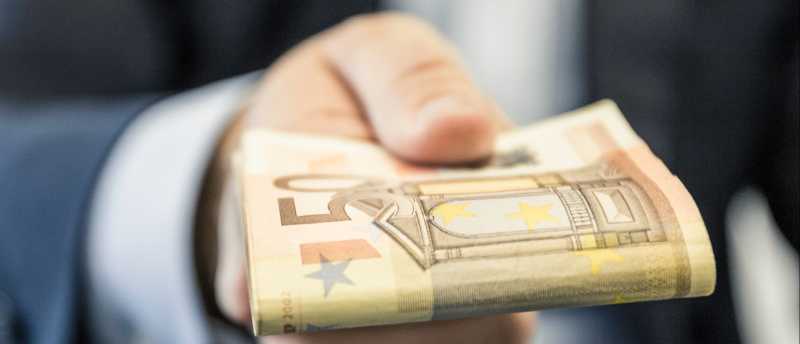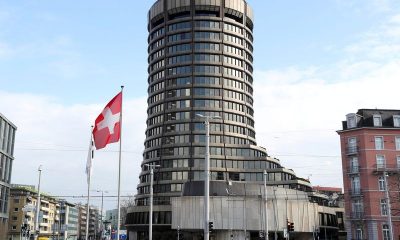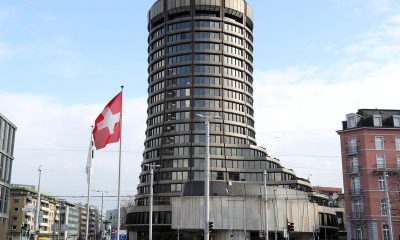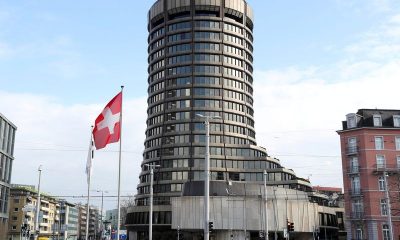Economy
Euro slides on weak business data; hawkish c.banks boost dollar

The euro fell after the bloc’s business growth virtually stalled this month, as the dollar drew support from a bout of risk aversion on Friday and hawkish comments from global central banks, including the Federal Reserve.
The dollar index, which measures the currency against six others, was up 0.56% at 102.95, reversing three straight weeks of losses. The euro slid 0.85% to $1.0859, heading for its biggest one-day fall since March.
The latest data showed euro zone business growth virtually stalled in June. A downturn in manufacturing deepened, while activity in the bloc’s dominant services sector barely expanded, as overall demand fell for the first time since January.
Business activity in Germany slowed in June as growth in the services sector decelerated and a decline in manufacturing worsened, while French business activity also contracted this month for the first time in five months.
Sterling struggled to hold gains from a larger-than-expected 50-basis-point rate rise from the Bank of England (BoE) on Thursday in response to sticky inflation, fuelling fears about an impending recession in the UK.
While higher rates are typically supportive of currencies, the risk that they will trigger an economic downturn has pushed some investors to seek safe-haven assets including the U.S. dollar.
The pound fell 0.31% to $1.2710 and was on track for a weekly loss of nearly 1%, snapping three straight weeks of gains.
“With the Bank of England set to raise rates substantially further, we expect the UK economy to come under renewed pressure by late 2023, and look for growth to either stagnate or even for the economy to contract,” said Nick Bennenbroek, international economist at Wells Fargo.
The Australian and New Zealand dollars also struggled in Asia trade as risk appetite waned.
The Aussie fell 1% to $0.6688 and was headed for a weekly loss of more than 2.5%, its worst week since March. The kiwi slid 0.58% to $0.6141, down about 1.5% for the week.
Rate hike surprises and hawkish comments from central banks globally have renewed market fears that policymakers have further to go in tightening policy to tame inflation, even at the risk of tipping their economies into a recession.
Norway’s central bank on Thursday also stunned markets with a 50-bp rate hike and said it aimed for another hike in August. The Swiss National Bank raised its policy interest rate by 25 bps the same day and signalled more tightening to come.
“Markets are definitely taken by surprise by the recent, more aggressive actions that some central banks had to take,” said Khoon Goh, head of Asia research at ANZ.
“Also putting into question the following trend of other central banks that initially looked like they’ve paused but went on to hike rates… so that’s something that markets are starting to become worried about again.”
The Reserve Bank of Australia and the Bank of Canada had earlier this month delivered surprise rate hikes when markets were leaning towards pauses.
Fed Chair Jerome Powell said on Thursday the central bank would move interest rates at a “careful pace” from here.
Money markets now see a 74% chance that the Fed will raise interest rates by 25 bps at its policy meeting next month, after leaving it unchanged last week.
THE YEN
The yen was largely steady at 143.05, languishing near an over seven-month low of 143.23 per dollar hit in the previous session.
The Japanese currency has come under renewed pressure as the Bank of Japan (BOJ) maintains an ultra-dovish stance.
Data out on Friday showed that Japan’s core consumer inflation exceeded forecasts in May and an index excluding fuel costs rose at the fastest annual pace in 42 years, putting pressure on the BOJ to phase out its massive stimulus.
Markets in China were closed for a holiday on Friday.
Economy
Russian central bank says it needs months to make sure CPI falling before rate cuts -RBC


© Reuters. Russian Central Bank Governor Elvira Nabiullina attends a news conference in Moscow, Russia June 14, 2019. REUTERS/Shamil Zhumatov/File Photo
MOSCOW (Reuters) – Russia’s central bank will need two to three months to make sure that inflation is steadily declining before taking any decision on interest rate cuts, the bank’s governor Elvira Nabiullina told RBC media on Sunday.
The central bank raised its key interest rate by 100 basis points to 16% earlier in December, hiking for the fifth consecutive meeting in response to stubborn inflation, and suggested that its tightening cycle was nearly over.
Nabiullina said it was not yet clear when exactly the regulator would start cutting rates, however.
“We really need to make sure that inflation is steadily decreasing, that these are not one-off factors that can affect the rate of price growth in a particular month,” she said.
Nabiullina said the bank was taking into account a wide range of indicators but primarily those that “characterize the stability of inflation”.
“This will take two or three months or more – it depends on how much the wide range of indicators that characterize sustainable inflation declines,” she said.
The bank will next convene to set its benchmark rate on Feb. 16.
The governor also said the bank should have started monetary policy tightening earlier than in July, when it embarked on the rate-hiking cycle.
Economy
China identifies second set of projects in $140 billion spending plan


© Reuters. FILE PHOTO: Workers walk past an under-construction area with completed office towers in the background, in Shenzhen’s Qianhai new district, Guangdong province, China August 25, 2023. REUTERS/David Kirton/File Photo
SHANGHAI (Reuters) – China’s top planning body said on Saturday it had identified a second batch of public investment projects, including flood control and disaster relief programmes, under a bond issuance and investment plan announced in October to boost the economy.
With the latest tranche, China has now earmarked more than 800 billion yuan of its 1 trillion yuan ($140 billion) in additional government bond issuance in the fourth quarter, as it focuses on fiscal steps to shore up the flagging economy.
The National Development and Reform Commission (NDRC) said in a statement on Saturday it had identified 9,600 projects with planned investment of more than 560 billion yuan.
China’s economy, the world’s second largest, is struggling to regain its footing post-COVID-19 as policymakers grapple with tepid consumer demand, weak exports, falling foreign investment and a deepening real estate crisis.
The 1 trillion yuan in additional bond issuance will widen China’s 2023 budget deficit ratio to around 3.8 percent from 3 percent, the state-run Xinhua news agency has said.
“Construction of the projects will improve China’s flood control system, emergency response mechanism and disaster relief capabilities, and better protect people’s lives and property, so it is very significant,” the NDRC said.
The agency said it will coordinate with other government bodies to make sure that funds are allocated speedily for investment and that high standards of quality are maintained in project construction.
($1 = 7.1315 renminbi)
Economy
Russian central bank says it needs months to make sure CPI falling before rate cuts -RBC


© Reuters. Russian Central Bank Governor Elvira Nabiullina attends a news conference in Moscow, Russia June 14, 2019. REUTERS/Shamil Zhumatov/File Photo
MOSCOW (Reuters) – Russia’s central bank will need two to three months to make sure that inflation is steadily declining before taking any decision on interest rate cuts, the bank’s governor Elvira Nabiullina told RBC media on Sunday.
The central bank raised its key interest rate by 100 basis points to 16% earlier in December, hiking for the fifth consecutive meeting in response to stubborn inflation, and suggested that its tightening cycle was nearly over.
Nabiullina said it was not yet clear when exactly the regulator would start cutting rates, however.
“We really need to make sure that inflation is steadily decreasing, that these are not one-off factors that can affect the rate of price growth in a particular month,” she said.
Nabiullina said the bank was taking into account a wide range of indicators but primarily those that “characterize the stability of inflation”.
“This will take two or three months or more – it depends on how much the wide range of indicators that characterize sustainable inflation declines,” she said.
The bank will next convene to set its benchmark rate on Feb. 16.
The governor also said the bank should have started monetary policy tightening earlier than in July, when it embarked on the rate-hiking cycle.

 Forex3 years ago
Forex3 years agoForex Today: the dollar is gaining strength amid gloomy sentiment at the start of the Fed’s week

 Forex3 years ago
Forex3 years agoUnbiased review of Pocket Option broker

 Forex3 years ago
Forex3 years agoDollar to pound sterling exchange rate today: Pound plummeted to its lowest since 1985

 Forex3 years ago
Forex3 years agoHow is the Australian dollar doing today?

 Cryptocurrency3 years ago
Cryptocurrency3 years agoWhat happened in the crypto market – current events today

 World3 years ago
World3 years agoWhy are modern video games an art form?

 Commodities3 years ago
Commodities3 years agoCopper continues to fall in price on expectations of lower demand in China

 Economy3 years ago
Economy3 years agoCrude oil tankers double in price due to EU anti-Russian sanctions



























